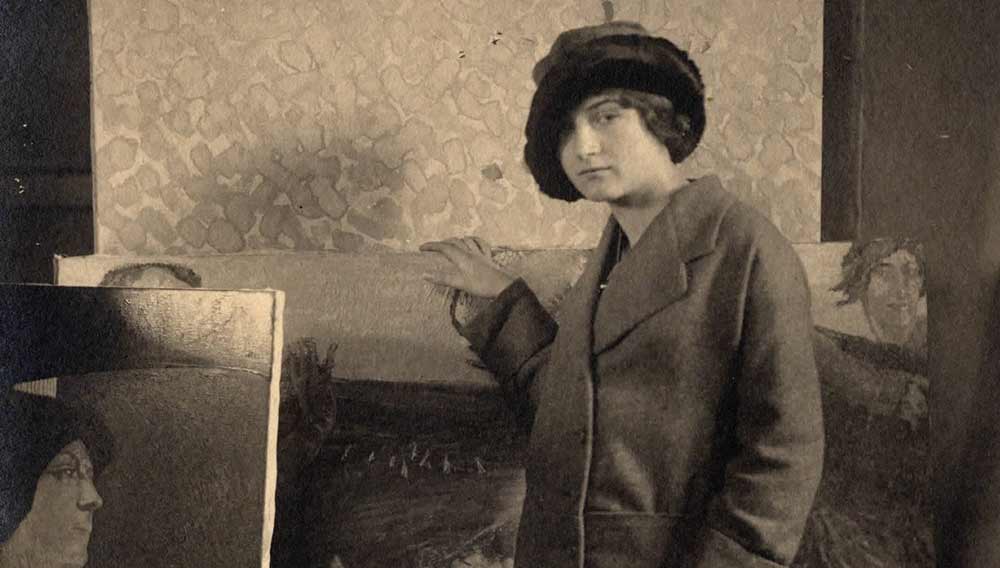
Pasquarosa in Rome, 1914.
Estorick Collection of Modern Italian Art, London
12 January – 28 April 2024
by ANNA McNAY
If I had walked into this colourful exhibition, knowing neither whose work it was nor the venue, I might have hazarded a guess at a fauve artist – Kees van Dongen, perhaps, or Henri Matisse. But then, noting the proliferation of flower paintings, I might have sought to name a female artist (not based solely on stereotypes, but because of the nature of these delicate yet resolute pieces) – Winifred Nicholson, for the hyacinths and cyclamen, maybe. But this is the Estorick Collection, home to modern Italian art. And there is, as one studies the paintings, a singularity to their unclassifiable tenor. Enter room one and you are seduced by juicy oranges (the colour not the fruit); room two, on the other hand, is redolent in red, with beams of sunshine yellow. The artist is Pasquarosa, known by her first name, which, literally translated, means Pentecost, and, while she may be unknown to general audiences today, she was, according to the exhibition catalogue, the “best-known woman painter in Italy” during the interwar years.
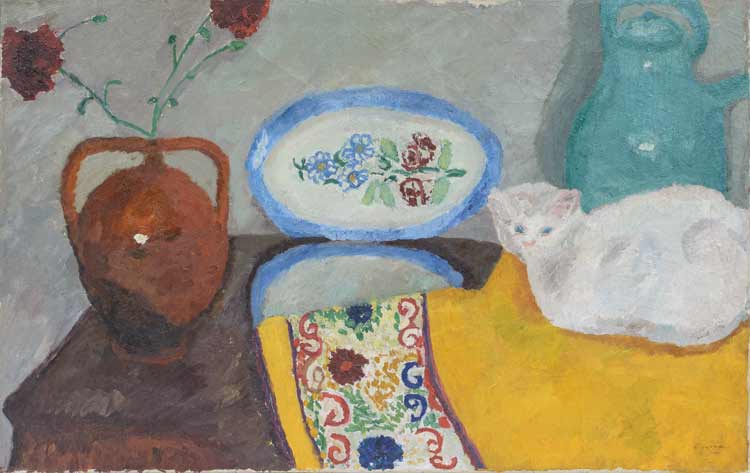
Pasquarosa. Still Life with Cat, 1918. Oil on canvas, 60 x 95 cm. Courtesy Archivio Nino e Pasquarosa Bertoletti, Rome.
Born in 1896 into a humble family, Pasquarosa Marcelli grew up with no formal education. As was common for the girls from her town – Anticoli Corrado, known as “the town of models” – Pasquarosa moved to Rome in 1912 to follow just this “career path”. She quickly came to know Umberto Natale (Nino) Bertoletti, sat for him, became pregnant, and married him in 1915. Bertoletti’s family, being far more well-to-do than Pasquarosa’s, disapproved of his chosen bride but she was intelligent and possessed a keen desire to learn. First with her husband, and later his wider circle of intellectual friends (especially the playwright Luigi Pirandello), she learned not only to read, but to do so voraciously. While he was away at the front during the first world war, Bertoletti sent her reading suggestions; by the time he returned, she was fluent and compiling her own reading list, covering everything from the Italian Romantic poet Giacomo Leopardi to Shakespeare.
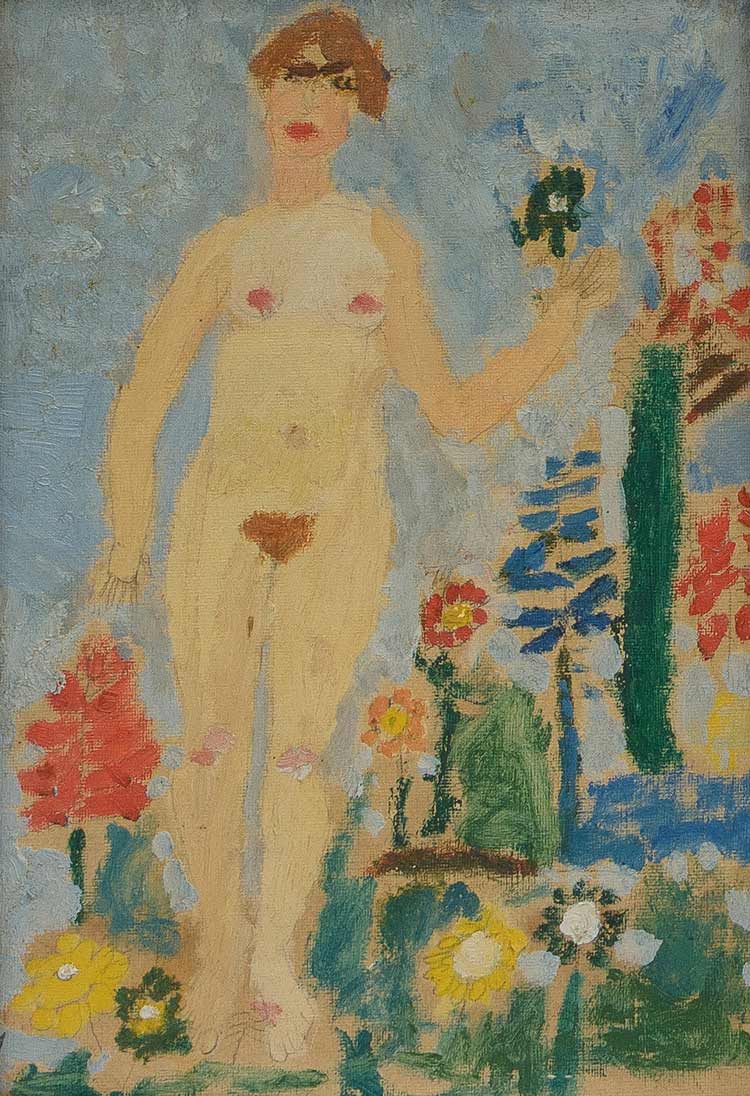
Pasquarosa. Small Nude, c1913. Oil on cardboard, 33 x 23 cm. Courtesy Archivio Nino e Pasquarosa Bertoletti, Rome.
She also began to paint, perhaps a little naively at first – see, for example, Small Nude (c1913), which has all the charm of a child’s self-portrait (excepting, of course, the womanly aspects). Soon, though, she was creating compositions that, while seemingly simple, flouted rules and rendering almost abstract patterns of blossoms against tablecloths (Zinnias, 1933), patchwork quilts (Still Life on a Rug and Flowers, both c1949), and modernist planes (Branches and Colours, c1959), or plants sitting on tables, where the edge of the object is a broken line, which in reality could never have met (Primulas, c1938).
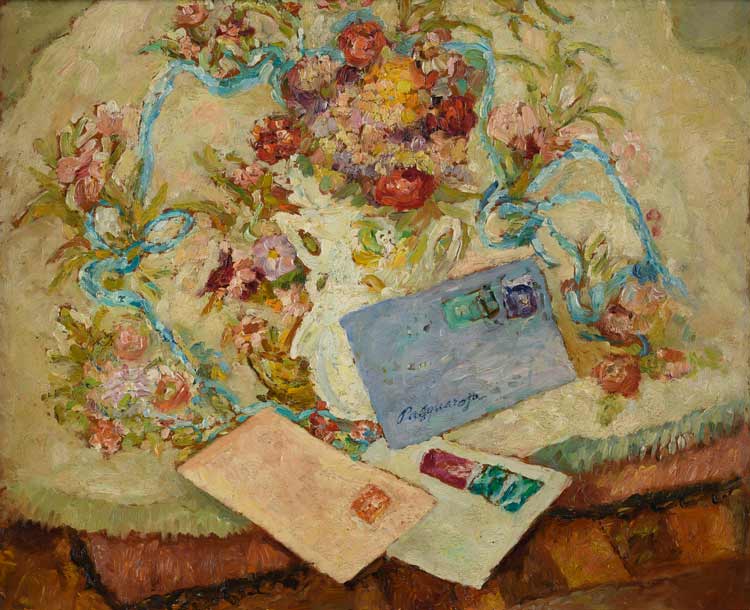
Pasquarosa. Vase of Flowers and Letters, c1950. Oil on board, 38 x 46 cm. Courtesy Archivio Nino e Pasquarosa Bertoletti, Rome.
Her signature is incorporated in clever ways, such as on an envelope (Vase of Flowers and Letters, c1950) and on the side of a box (Still Life with Oranges, Vase and Japanese Box, 1914-15), and she frequently also includes references to reading, such as an open book (Violet Primulas, 1931) or a magazine (Cyclamen, c1939). As her style progresses, her paintwork becomes increasingly impasto, with thick blobs forming each individual petal of a head of blossom (White Flowers, c1958-60 and Flowers, c1949-50).
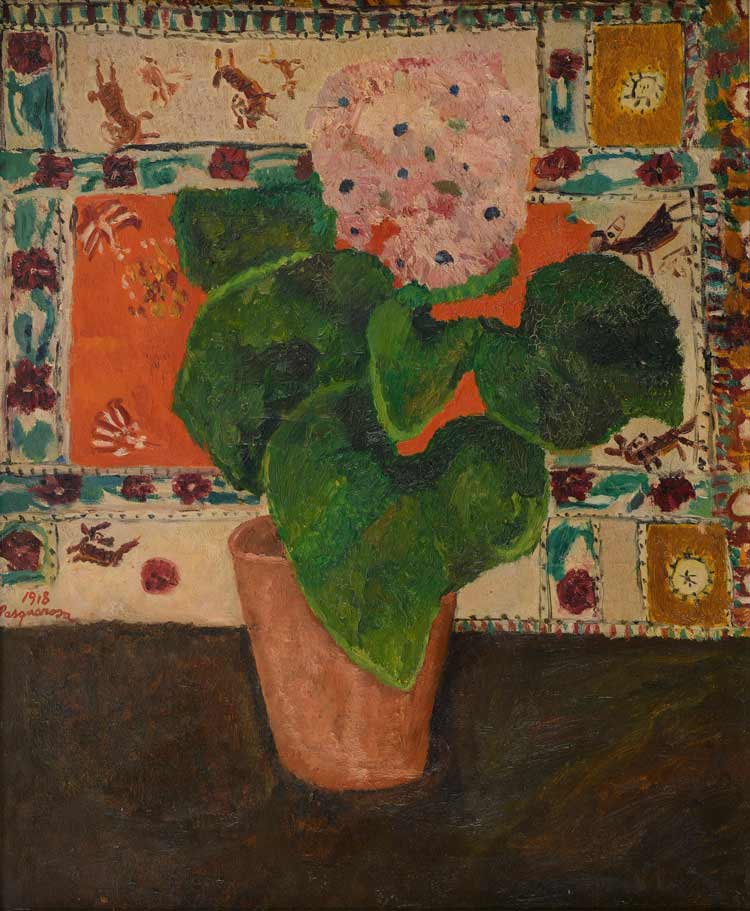
Pasquarosa. Pink Cineraria, 1918. Oil on canvas, 74 x 61 cm. Courtesy Archivio Nino e Pasquarosa Bertoletti, Rome.
As well as being surrounded by the literati in Bertoletti’s circle, Pasquarosa also found herself surrounded by artists in Rome. My guess at the fauves would not have been so wildly wrong, since she was doubtless influenced by those whose works she would have seen exhibited in the city, Van Dongen and Matisse among them. Russian avant-garde artists, such as Natalia Goncharova and Mikhail Larionov, were also frequent visitors. When Picasso had an exhibition there, Pasquarosa was invited. Pier Paolo Pancotto, who has curated this exhibition at the Estorick Collection, describes her as a “proto-feminist”, who used her intelligence and sensitivity to forward her career, sidelining her natural beauty. (He even notes her weight gain as a sign of her claiming further freedoms.)
Her paintings were exhibited as early as 1915 at an exhibition of the Roman secessionist group. There was an unexpected and positive critical response, with her fellow artist Cipriano Efisio Oppo labelling her a “phenomenon” and the anti-fascist intellectual Carlo Levi praising her “simple authenticity and expression of truths that spring straight from the heart”. Giorgio de Chirico, who notoriously bore very little company of others, welcomed Pasquarosa and Bertoletti into his circle and is said to have been impressed by Pasquarosa’s “freshness”. He also wrote to Bertoletti recalling a delicious meal she had cooked them. The metaphysical painter had his debut in London in 1928, and Pasquarosa followed suit, but a year later at the Arlington Gallery, on Old Bond Street, where she showed 39 paintings. That she had a solo show in London as an Italian artist was achievement enough, but as a female Italian artist she was in a league of her own.
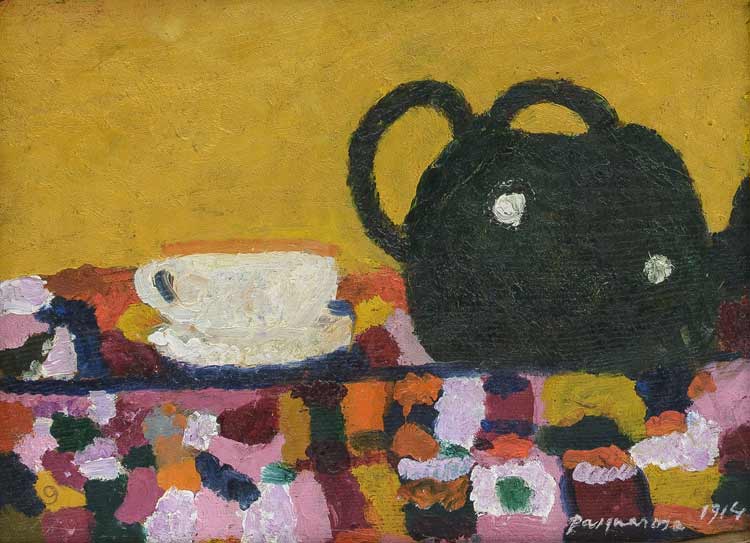
Pasquarosa. Teapot on a Rug, 1914. Oil on linen cardboard, 30 x 40 cm. Courtesy Archivio Nino e Pasquarosa Bertoletti, Rome.
Although she travelled to Turin, Madrid, Nice and Geneva, and spent three months in Paris in the year of her London debut, there is no evidence that Pasquarosa came to the UK. This may be due to her sons – Giorgio and Carlo Francesco – born in 1916 and 1924 respectively. Following the birth of the younger, it seems she took some time out to focus on her role as a mother. But her works were included in the Venice Biennale in 1930 – and she went on to participate in 1932, 1934, 1936, 1948 and 1954 – and the Rome Quadriennale for the first time in 1931. She has paintings in the collections of many of Italy’s major museums, but, nevertheless, there was never any particular market for her pieces. Add to that, of course, that her career was overshadowed by her husband’s, for whom she served not only as muse, but, from certain telltale signs, she may well have assisted.
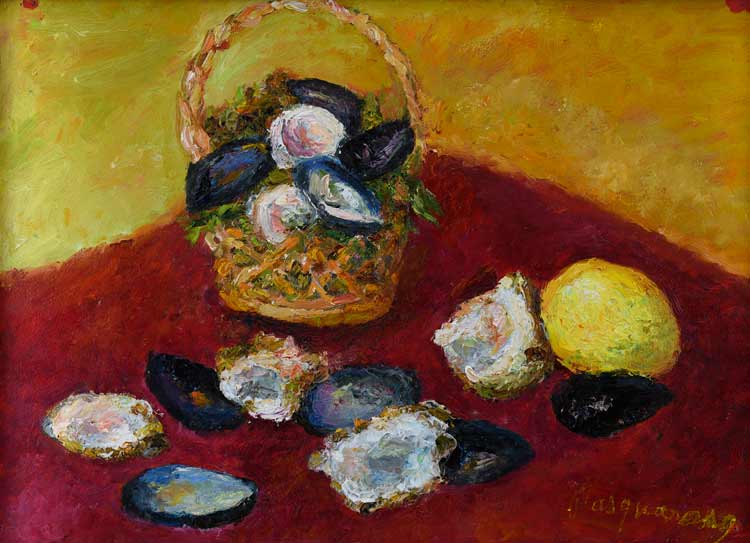
Pasquarosa. Oysters, Mussels and Lemon, c1963. Oil on cardboard, 33 x 44 cm. Courtesy Archivio Nino e Pasquarosa Bertoletti, Rome.
Pancotto might describe this exhibition as something of a labour of love. Normally working only with living artists, he has nevertheless devoted many hours to Pasquarosa, whom he met in his student days, while working on a catalogue of hers. While he has deliberately limited the works on display to those in the Archivio Nino e Pasquarosa Bertoletti, Rome (an archive established and run by the Bertoletti family), his research has been thorough and has left virtually no stone unturned. In room one, the visitor can enjoy a loop of home videos, filmed by Bertoletti, capturing Pasquarosa with friends in Paris and Castiglioncello, as well as playing boules. Another found treasure is the catalogue produced to accompany Pasquarosa’s exhibition at the Arlington Gallery. Alongside a short essay by the Italian critic Emilio Cecchi – which describes her “sensitive calm”, “clean sense of limits”, “genial conception” and “love with which the subject is treated” – it contains a list of works. An even better find, however, are the various photographs of some of these works, printed alongside newspaper reviews at the time. Black-and-white reproductions are included in one of four vitrines in the second room, and Pancotto hopes someone may come along and recognise one of them, helping him pin down their present-day owners.
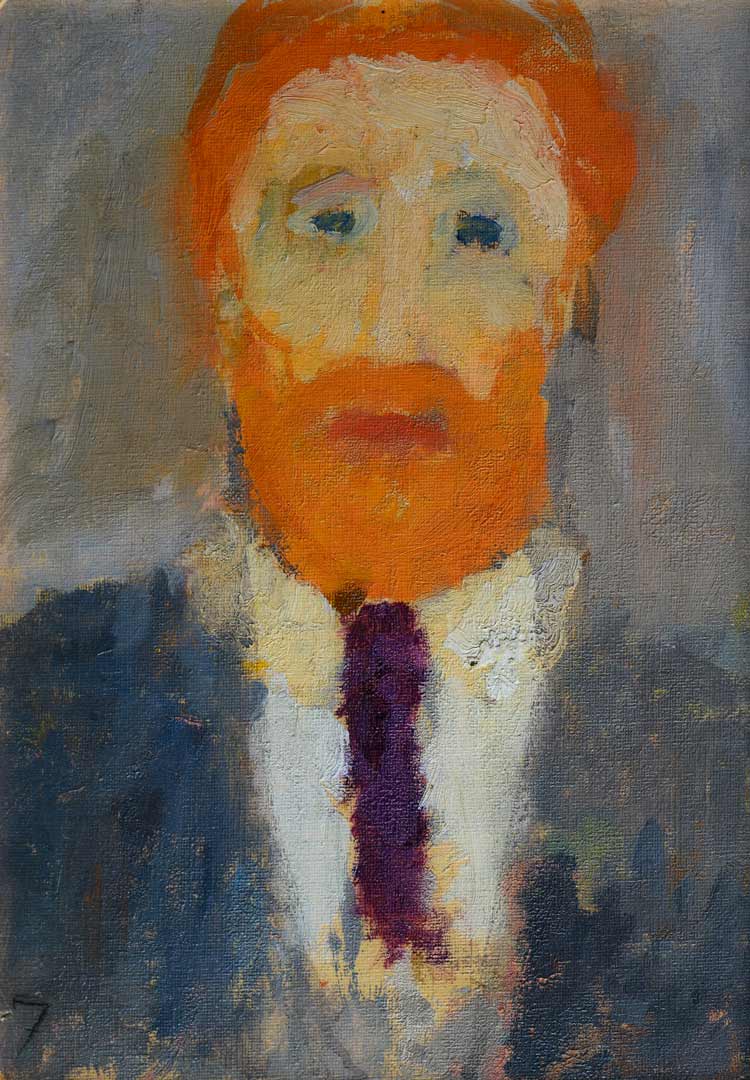
Pasquarosa. Felice Carena, 1915. Oil on pressed cardboard, 33.5 x 23 cm. Courtesy Archivio Nino e Pasquarosa Bertoletti, Rome.
The other three vitrines contain the most delightful assortment of sketches by Bertoletti, the majority depicting his wife as his muse, and some in which she tenderly cradles a cat, much as if it were a newborn child. His confident sweeps of pen or pencil mirror Pasquarosa’s jubilant use of colour. These drawings are further accompanied by photographs of models, including Pasquarosa at work for Bertoletti. One wall of this room is given over to paintings by Bertoletti – each portraying his wife at a different point in her life, from 1914 to 1940, some of these also including books. Of the five, Portrait of Pasquarosa (1923) strikes me the most, with the sketchy cream paint behind her head giving her a Madonna-like appearance, as if surrounded by a halo of light. There is none from later years, but Bertoletti lived until 1971, and Pasquarosa survived him by two years, so I wonder whether there are further portraits showing her as she aged, or whether, for whatever reason, she ceased to be his muse. Somehow that is hard to believe, for this exceptional woman – or “beautiful creature” (as she was described by an American critic in 1929 – presumably not quite as condescending as such a “compliment” might be construed today) – producing works so full of joie de vivre, can surely never have ceased to inspire.
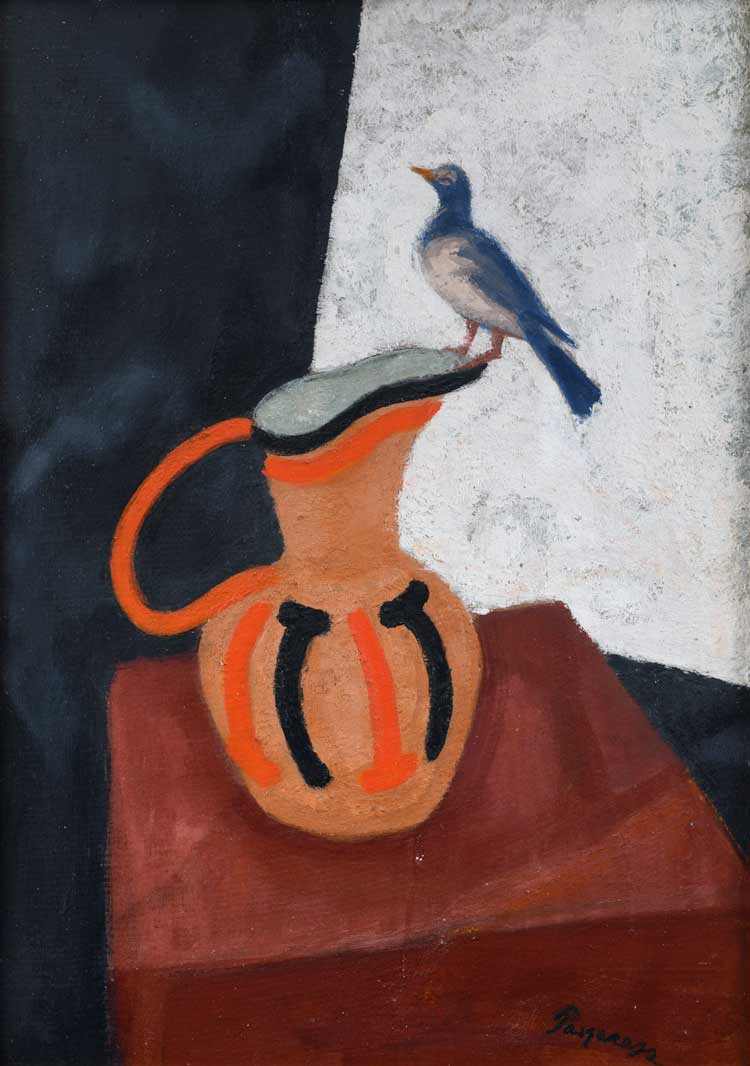
Pasquarosa. Jug and Little Bird, c1918-30. Oil on pressed cardboard, 68 x 48 cm. Courtesy Archivio Nino e Pasquarosa Bertoletti, Rome.